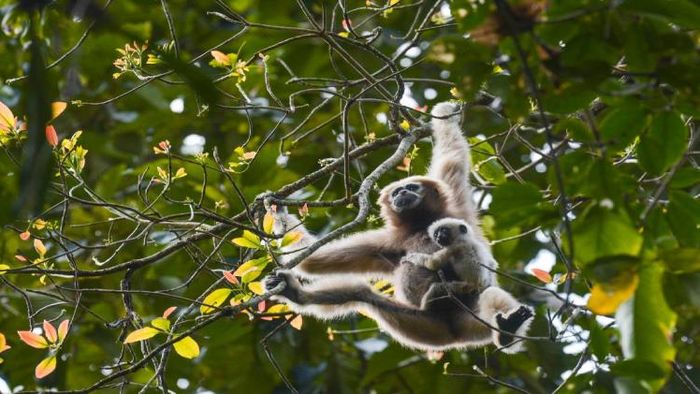Assam’s Dihing Patkai slowly losing the conspicuous sounds of the endangered Hoolock Gibbon
Any one-sided conservation effort would appear to be insufficient in this situation to protect the Hoolock gibbon population and its rainforest habitats. As a result, there is a need to intensify conservation efforts through activism and education.

- Oct 12, 2022,
- Updated Oct 12, 2022, 5:08 PM IST
The Dihing Patkai National Park in Assam’s Dibrugarh district is the stronghold for the endangered Hoolock Gibbon.
However, despite being formally promoted to a national park, the park's infrastructure is relatively subpar, with minimal employees and resources. The livelihood of the villages that surround the sanctuary and those on the outskirts is largely reliant on the forest.
The main issues include a lack of understanding and motivation among the forest employees to prevent illicit activities and a lack of understanding of the sanctuary's significance among the surrounding population.
Any one-sided conservation effort would appear to be insufficient in this situation to protect the Hoolock gibbon population and its rainforest habitats. As a result, there is a need to intensify conservation efforts through activism and education.
Speaking exclusively to India Today NE, young environmentalist and wildlife photographer Tomal Gogoi lamented on the decreasing numbers of the Hoolock Gibbon population in Dihing Patkai National Park, “During a regular Sunday visit to my favourite place, the last lowland rainforest of India, Dihing Patkai National Park for birding, we entered the forest when it was dark and a slow breeze wind was blowing. I was so excited as I was at my favourite place, looking carefully everywhere with pin drop silence.”
“I was lost as I was observing a very beautiful flycatcher species then suddenly heard a loud and conspicuous sound "hoo koo hoo kuu" which blew my mind as I was concentrating on the flycatcher. Then after a few steps back on the other side of the tree I can see Endangered Primates swinging lithely from branch to branch high up in the forest canopy on a Endangered Tree, the only ape found in India where the male are black and female are creamy whitish colour Western Hoolock Gibbon (Hoolock hoolock),” added Tomal.
Gibbons have faced dual threats of hunting and habitat loss where the population has decreased more than 90% in the past 30 years for which it has been marked as endangered species by IUCN as there are less than 10,000 (approx) gibbons in India.
“The group consisted of two male, one female with its juvenile, the moment was so captivating and a valuable one where I saw the love, care, responsibility towards its juvenile as its mother,” added Tomal.
Continuing with his experiences after staying engrossed in the rich flora and fauna that Dihing Patkai national park inhibits, Tomal said that the park has many secrets of nature that is yet to be tapped, but fear of the relentless attacks of the poachers and illegal activities that continue unabated inside the green cover.
“On the other hand I was also very afraid of the elephants too as it has many records of elephant and Hhuman encounters. After birding and exploring the rich flora and fauna of the very dense rainforest, Dihing Patkai, if you look at the tall straight towering like trees, they are more than 30 meters tall. As my first half passed I went under a huge Hollong tree (Dipterocarpus retusus) which is also state tree of Assam, for taking some rest and then suddenly a flock with Red-headed trogon (Harpactes erythrocephalus), Greater necklaced laughingthrush (Pterorhinus pectoralis), Greater yellownape (Chrysophlegma flavinucha), Greater racket-tailed drongo (Dicrurus paradiseus) and Blyth's Paradise Flycatcher (Terpsiphone affinis) flew in front of me and sat on a open bamboo, it took my attention.”